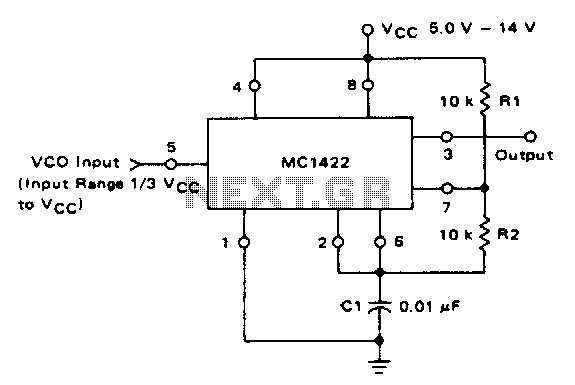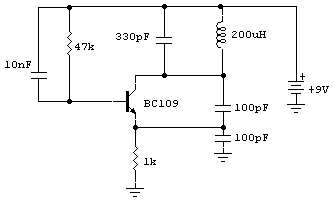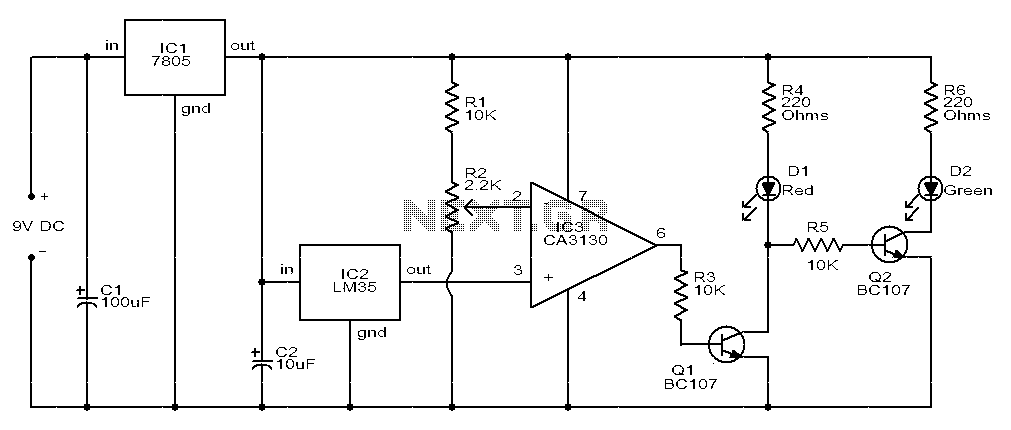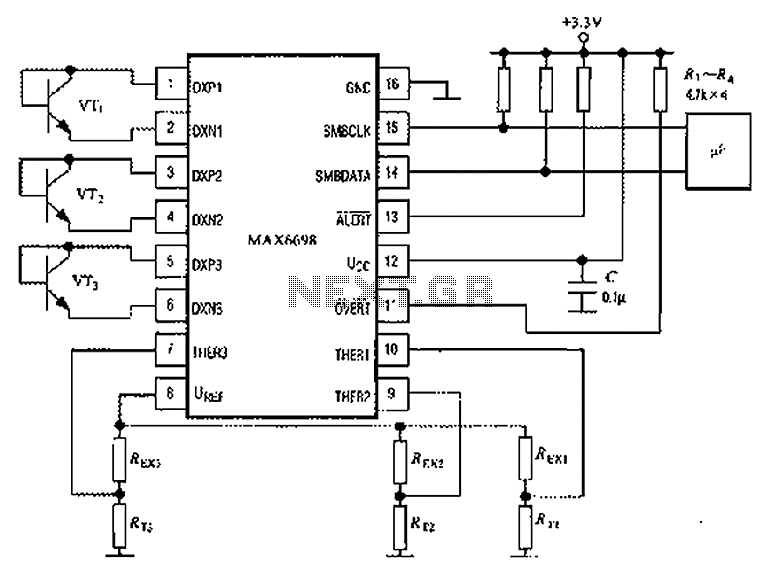
Temperature controlled oscillator
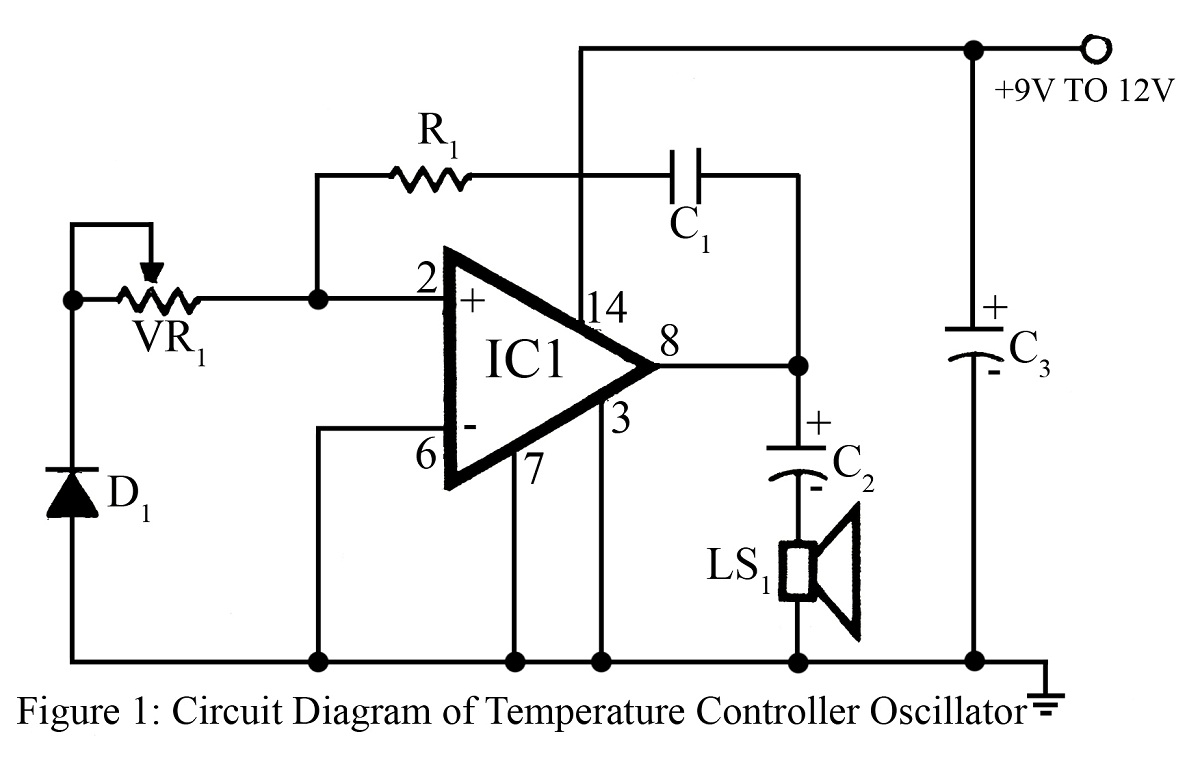
The output frequency or tone of this oscillator circuit varies with the temperature at which the input germanium diode is maintained. The reverse resistance of D1 ranges from 500 ohms to 10 k ohms when the temperature fluctuates between 20°C and 80°C. At elevated temperatures, germanium devices exhibit very low resistance. This variation in resistance alters the tone of the output sound generated by the oscillator, which is constructed around the AF amplifier IC (IC1). Instead of using a germanium diode, the base-emitter junction of a standard medium-power transistor, such as AC128, AC188, 2N360, or 2N610, can be utilized. This circuit is not compatible with silicon diodes.
The described oscillator circuit operates by leveraging the temperature-dependent characteristics of a germanium diode to modulate its output frequency. The germanium diode (D1) serves as a critical component, where its reverse resistance significantly changes with temperature variations. This property is exploited to create an oscillator whose frequency or tone is directly influenced by ambient temperature conditions.
In practical applications, the circuit may be designed using an AF amplifier IC (IC1) as the core component. The AF amplifier is responsible for amplifying the modulated signal generated by the oscillator. The choice of the germanium diode is essential, as its unique characteristics allow for a broader range of frequency modulation compared to silicon diodes, which do not exhibit the same level of temperature sensitivity.
For enhanced flexibility, the circuit can be adapted to use the base-emitter junction of medium-power transistors such as the AC128, AC188, 2N360, or 2N610. These transistors can effectively replace the germanium diode while still maintaining the circuit's functionality. However, it is crucial to note that the circuit will not operate correctly with silicon diodes due to their differing electrical properties, which lack the necessary temperature response.
Overall, this oscillator circuit presents an intriguing application of temperature-sensitive components, providing unique sound modulation capabilities that can be utilized in various electronic projects, including temperature sensors, sound generators, and educational demonstrations of semiconductor behavior. Proper component selection and circuit design will ensure optimal performance and reliability in practical implementations.Output frequency or tone of this oscillator circuit varies with the temperature at which the input germanium diode is held. Reverse resistance of D1 varies from 500- © to 10 K ©, when temperature varies between 200C and 800C.
(At higher temperature germanium devices show very low resistance. ) This variation of resistance changes the tone of the ou tput sound of the oscillator which is built around the AF amplifier IC (IC1). Instead of germanium diode, base-emitter junction of an ordinary medium-power transistor such as AC128, AC188, 2N360 or 2N610 can be used. This circuit will not work with silicon diodes. 🔗 External reference
The described oscillator circuit operates by leveraging the temperature-dependent characteristics of a germanium diode to modulate its output frequency. The germanium diode (D1) serves as a critical component, where its reverse resistance significantly changes with temperature variations. This property is exploited to create an oscillator whose frequency or tone is directly influenced by ambient temperature conditions.
In practical applications, the circuit may be designed using an AF amplifier IC (IC1) as the core component. The AF amplifier is responsible for amplifying the modulated signal generated by the oscillator. The choice of the germanium diode is essential, as its unique characteristics allow for a broader range of frequency modulation compared to silicon diodes, which do not exhibit the same level of temperature sensitivity.
For enhanced flexibility, the circuit can be adapted to use the base-emitter junction of medium-power transistors such as the AC128, AC188, 2N360, or 2N610. These transistors can effectively replace the germanium diode while still maintaining the circuit's functionality. However, it is crucial to note that the circuit will not operate correctly with silicon diodes due to their differing electrical properties, which lack the necessary temperature response.
Overall, this oscillator circuit presents an intriguing application of temperature-sensitive components, providing unique sound modulation capabilities that can be utilized in various electronic projects, including temperature sensors, sound generators, and educational demonstrations of semiconductor behavior. Proper component selection and circuit design will ensure optimal performance and reliability in practical implementations.Output frequency or tone of this oscillator circuit varies with the temperature at which the input germanium diode is held. Reverse resistance of D1 varies from 500- © to 10 K ©, when temperature varies between 200C and 800C.
(At higher temperature germanium devices show very low resistance. ) This variation of resistance changes the tone of the ou tput sound of the oscillator which is built around the AF amplifier IC (IC1). Instead of germanium diode, base-emitter junction of an ordinary medium-power transistor such as AC128, AC188, 2N360 or 2N610 can be used. This circuit will not work with silicon diodes. 🔗 External reference
Warning: include(partials/cookie-banner.php): Failed to open stream: Permission denied in /var/www/html/nextgr/view-circuit.php on line 713
Warning: include(): Failed opening 'partials/cookie-banner.php' for inclusion (include_path='.:/usr/share/php') in /var/www/html/nextgr/view-circuit.php on line 713
